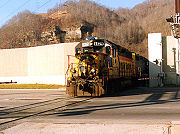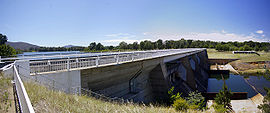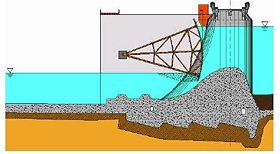
Floodgate
Encyclopedia
Floodgates are adjustable gates used to control water flow in flood barrier
s, reservoir
, river
, stream
, or levee
systems. They may be designed to set spillway
crest heights in dam
s, to adjust flow rates in sluice
s and canals, or they may be designed to stop water flow entirely as part of a levee or storm surge
system. Since most of these devices operate by controlling the water surface elevation being stored or routed, they are also known as crest gates. In the case of flood bypass systems, floodgates sometimes are also used to lower the water levels in a main river or canal channels by allowing more water to flow into a flood bypass or detention basin
when the main river or canal is approaching a flood stage.
Other design requirements include taking into account pressure head operation, the flow rate, whether the valve operates above or below water, and the regulation of precision and cost.
:

where:
If the rectangular flood gate is submerged below the surface the same equation can be used but only the height from the water surface to the middle of the gate must be used to calculate the force on the flood gate.
Flood barrier
A flood barrier, surge barrier of storm surge barrier is a specific type of floodgate, designed to prevent a storm surge or spring tide from flooding the protected area behind the barrier...
s, reservoir
Lake
A lake is a body of relatively still fresh or salt water of considerable size, localized in a basin, that is surrounded by land. Lakes are inland and not part of the ocean and therefore are distinct from lagoons, and are larger and deeper than ponds. Lakes can be contrasted with rivers or streams,...
, river
River
A river is a natural watercourse, usually freshwater, flowing towards an ocean, a lake, a sea, or another river. In a few cases, a river simply flows into the ground or dries up completely before reaching another body of water. Small rivers may also be called by several other names, including...
, stream
Stream
A stream is a body of water with a current, confined within a bed and stream banks. Depending on its locale or certain characteristics, a stream may be referred to as a branch, brook, beck, burn, creek, "crick", gill , kill, lick, rill, river, syke, bayou, rivulet, streamage, wash, run or...
, or levee
Levee
A levee, levée, dike , embankment, floodbank or stopbank is an elongated naturally occurring ridge or artificially constructed fill or wall, which regulates water levels...
systems. They may be designed to set spillway
Spillway
A spillway is a structure used to provide the controlled release of flows from a dam or levee into a downstream area, typically being the river that was dammed. In the UK they may be known as overflow channels. Spillways release floods so that the water does not overtop and damage or even destroy...
crest heights in dam
Dam
A dam is a barrier that impounds water or underground streams. Dams generally serve the primary purpose of retaining water, while other structures such as floodgates or levees are used to manage or prevent water flow into specific land regions. Hydropower and pumped-storage hydroelectricity are...
s, to adjust flow rates in sluice
Sluice
A sluice is a water channel that is controlled at its head by a gate . For example, a millrace is a sluice that channels water toward a water mill...
s and canals, or they may be designed to stop water flow entirely as part of a levee or storm surge
Storm surge
A storm surge is an offshore rise of water associated with a low pressure weather system, typically tropical cyclones and strong extratropical cyclones. Storm surges are caused primarily by high winds pushing on the ocean's surface. The wind causes the water to pile up higher than the ordinary sea...
system. Since most of these devices operate by controlling the water surface elevation being stored or routed, they are also known as crest gates. In the case of flood bypass systems, floodgates sometimes are also used to lower the water levels in a main river or canal channels by allowing more water to flow into a flood bypass or detention basin
Detention basin
A detention basin is a stormwater management facility installed on, or adjacent to, tributaries of rivers, streams, lakes or bays that is designed to protect against flooding and, in some cases, downstream erosion by storing water for a limited period of a time. These basins are also called "dry...
when the main river or canal is approaching a flood stage.
Types
 |
 |
- Bulkhead gates are vertical walls with movable, or re-movable, sections. Movable sections can be lifted to allow water to pass underneath (as in a sluice gateSluiceA sluice is a water channel that is controlled at its head by a gate . For example, a millrace is a sluice that channels water toward a water mill...
) and over the top of the structure. Historically, these gates used stacked timbers known as stoplogsStoplogsStoplogs are a hydraulic engineering control element that are used in floodgates to adjust the water level or flow rate in a river, canal, or reservoir. Stoplogs are sometimes confused with flashboards, as both elements are used in bulkhead or crest gates...
or wooden panels known as flashboards to set the dam's crest height. Some floodgates known as coupureCoupureA coupure is a means of closing an opening in a wall, floodwall or levee . The word comes from the french verb couper which means to cut....
s in large levee systems slide sideways to open for various traffic. Bulkhead gates can also be made of other materials and used as a single bulkhead unit. Miter gates are used in ship locks and usually close at an 18° angle to approximate an arch.
 |
- Hinged crest gates, are wall sections that rotate from vertical to horizontal, thereby varying the height of the dam. They are generally controlled with hydraulic powerHydraulic machineryHydraulic machines are machinery and tools that use liquid fluid power to do simple work. Heavy equipment is a common example.In this type of machine, hydraulic fluid is transmitted throughout the machine to various hydraulic motors and hydraulic cylinders and which becomes pressurised according to...
, although some are passive and are powered by the water being impounded.
- Variations;
- flap gate fish-belly flap gates
- Bascule gates
- Pelican gates
 |
- Radial gates are rotary gates consisting of cylindrical sections. They may rotate vertically or horizontally. Tainter gateTainter gateThe Tainter gate is a type of radial arm floodgate used in dams and canal locks to control water flow. It is named for Wisconsin structural engineer Jeremiah Burnham Tainter....
s are a vertical design that rotates up to allow water to pass underneath. Low friction trunnionTrunnionA trunnion is a cylindrical protrusion used as a mounting and/or pivoting point. In a cannon, the trunnions are two projections cast just forward of the centre of mass of the cannon and fixed to a two-wheeled movable gun carriage...
bearingsBearing (mechanical)A bearing is a device to allow constrained relative motion between two or more parts, typically rotation or linear movement. Bearings may be classified broadly according to the motions they allow and according to their principle of operation as well as by the directions of applied loads they can...
, along with a face shape that balances hydrostatic forces, allow this design to close under its own weight as a safety feature.
- Drum gates are hollow gate sections that float on water. They are pinned to rotate up or down. Water is allowed into or out of the flotation chamber to adjust the dam's crest height.
- Roller gates are large cylinders that move in an angled slot. They are hoisted with a chain and have a cogged design that interfaces with their slot.
- Clamshell gates have an external clamshell leaf design.
- Fusegates are an innovative spillway control technology, which consists of free standing blocks (the Fusegates) set side by side on a flattened spillway sill. The Fusegate blocks act as a fixed weir most of the time and operate independently without any remote control or energy source only in case of excessive flood conditions. The System is developed and patented by Hydroplus from Paris, France. It has been installed on more than 50 dams around the world with sizes ranging from 1m to more than 9m in height. Fusegate are typically used to increase the storage capacity of existing dams or to maximize the discharge potential of undersized spillways.
Valves
Valves used in floodgate applications have a variety of design requirements and are usually located at the base of dams. Often, the most important requirement (besides regulating flow) is energy dissipation. Since water is very heavy, it exits the base of a dam with the enormous force of water pushing from above. Unless this energy is dissipated, the flow can erode nearby rock and soil and damage structures.Other design requirements include taking into account pressure head operation, the flow rate, whether the valve operates above or below water, and the regulation of precision and cost.
- Fixed cone valves, also known as Howell-Bunger valves, are designed to dissipate the energy from a water flow during reservoir discharge. They are a round pipe section with an adjustable sleeve gate and cone at the discharge end. Flow is varied by moving the sleeve away or towards its cone seat. The design allows high pressure water from the base of a damDamA dam is a barrier that impounds water or underground streams. Dams generally serve the primary purpose of retaining water, while other structures such as floodgates or levees are used to manage or prevent water flow into specific land regions. Hydropower and pumped-storage hydroelectricity are...
to be released without causing erosionErosionErosion is when materials are removed from the surface and changed into something else. It only works by hydraulic actions and transport of solids in the natural environment, and leads to the deposition of these materials elsewhere...
to the surrounding environment. Fixed cone valves are able to handle heads up to 300 m.
- Hollow jet valves are a type of needle valveNeedle valveA needle valve is a type of valve having a small port and a threaded, needle-shaped plunger. It allows precise regulation of flow, although it is generally only capable of relatively low flow rates.- Construction and operation :...
used for floodgate discharge. A cone and seat are inside a pipe. Water flows through an annular gap between the pipe and cone when it is moved downstream, away from the seat. Ribs support the bulb assembly and supply air for water jet stabilization.
- Ring jet valves are similar to fixed cone valves, but have an integral collar that discharges water in a narrow stream. They are suitable for heads up to 50 m.
- Jet flow gate, similar to a gate valveGate valveThe gate valve, also known as a sluice valve, is a valve that opens by lifting a round or rectangular gate/wedge out of the path of the fluid. The distinct feature of a gate valve is the sealing surfaces between the gate and seats are planar, so gate valves are often used when a straight-line flow...
but with a conical restriction prior to the gate leaf that focuses the water into a jet. They were developed in the 1940s by the United States Bureau of ReclamationUnited States Bureau of ReclamationThe United States Bureau of Reclamation , and formerly the United States Reclamation Service , is an agency under the U.S...
to allow fine control of discharge flow without the cavitationCavitationCavitation is the formation and then immediate implosion of cavities in a liquidi.e. small liquid-free zones that are the consequence of forces acting upon the liquid...
seen in regular gate valves. Jet flow gates are able to handle heads up to 150 m.
Physics
In order to do a simple calculation of the force on a rectangular flood gate one can use the following equationEquation
An equation is a mathematical statement that asserts the equality of two expressions. In modern notation, this is written by placing the expressions on either side of an equals sign , for examplex + 3 = 5\,asserts that x+3 is equal to 5...
:

where:
- F = force measured in the SISiSi, si, or SI may refer to :- Measurement, mathematics and science :* International System of Units , the modern international standard version of the metric system...
units kg·m·s–2 which is called the newton (N) - p = pressure
 measured in N/m2, which is called the pascalPascal (unit)The pascal is the SI derived unit of pressure, internal pressure, stress, Young's modulus and tensile strength, named after the French mathematician, physicist, inventor, writer, and philosopher Blaise Pascal. It is a measure of force per unit area, defined as one newton per square metre...
measured in N/m2, which is called the pascalPascal (unit)The pascal is the SI derived unit of pressure, internal pressure, stress, Young's modulus and tensile strength, named after the French mathematician, physicist, inventor, writer, and philosopher Blaise Pascal. It is a measure of force per unit area, defined as one newton per square metre...
(Pa)-
- where:
- ρ (rhoRhoRho is the 17th letter of the Greek alphabet. In the system of Greek numerals, it has a value of 100. It is derived from Semitic resh "head"...
) is the densityDensityThe mass density or density of a material is defined as its mass per unit volume. The symbol most often used for density is ρ . In some cases , density is also defined as its weight per unit volume; although, this quantity is more properly called specific weight...
of fresh water (1000 kg/m3); - g is the acceleration due to gravityGeeGee may refer to:In fiction:*Al Giardello , a fictional character on the television drama Homicide: Life on the StreetIn record labels:*Gee Records*Gee Street RecordsIn music:...
on Earth (9.8 m/s2 ); - h is the height of the water column in meters.
- ρ (rho
- where:
-
- A = area = rectangleRectangleIn Euclidean plane geometry, a rectangle is any quadrilateral with four right angles. The term "oblong" is occasionally used to refer to a non-square rectangle...
: lengthLengthIn geometric measurements, length most commonly refers to the longest dimension of an object.In certain contexts, the term "length" is reserved for a certain dimension of an object along which the length is measured. For example it is possible to cut a length of a wire which is shorter than wire...
× heightHeightHeight is the measurement of vertical distance, but has two meanings in common use. It can either indicate how "tall" something is, or how "high up" it is. For example "The height of the building is 50 m" or "The height of the airplane is 10,000 m"...
measured in m2-
- where:
- length = the horizontal length of a rectangular floodgate measured in meters
- height = the height of a non-submerged flood gate from the bottom of the water column to the water surface measured in meters
-
If the rectangular flood gate is submerged below the surface the same equation can be used but only the height from the water surface to the middle of the gate must be used to calculate the force on the flood gate.
See also
- Tidal barrageTidal barrageA tidal barrage is a dam-like structure used to capture the energy from masses of water moving in and out of a bay or river due to tidal forces....
- Canal lock
- Thames BarrierThames BarrierThe Thames Barrier is the world's second-largest movable flood barrier and is located downstream of central London. Its purpose is to prevent London from being flooded by exceptionally high tides and storm surges moving up from the sea...
- Delta WorksDelta WorksThe Delta Works is a series of construction projects in the southwest of the Netherlands to protect a large area of land around the Rhine-Meuse-Scheldt delta from the sea. The works consist of dams, sluices, locks, dikes, levees, and storm surge barriers...
- OosterscheldekeringOosterscheldekeringThe Oosterscheldekering , between the islands Schouwen-Duiveland and Noord-Beveland, is the largest of the 13 ambitious Delta works series of dams, designed to protect the Netherlands from flooding...
- Oosterscheldekering
Sources
- US Army Corps of Engineers. (31 July 1995). Engineering manual 1110-2-2607, Planning and Design of Navigation Dams, Chapter 5, Overview of gate types. Retrieved 2008-04-14.
External links
- DeltaWorks.Org – project in the Netherlands on floodgates

